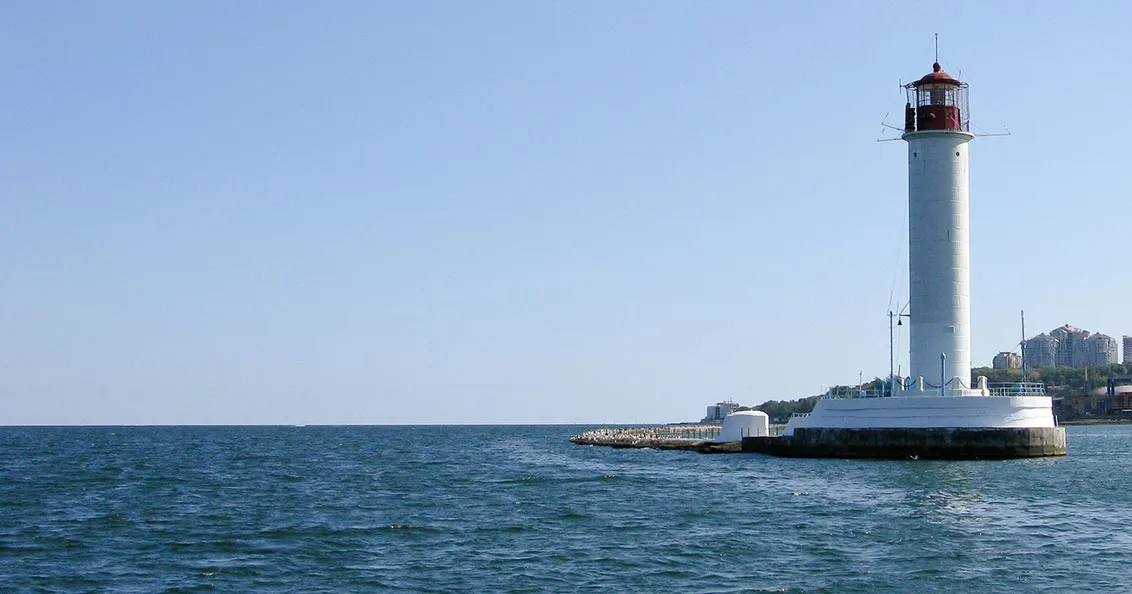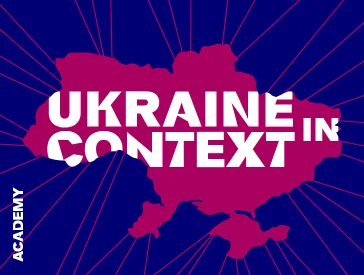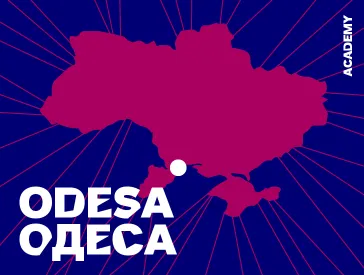Odesa as a Site of Jewish Utopian Dreams
Interview with Anna Misyuk, Former Curator of the Odesa Literary Museum

The spirit of Odesa emerged primarily with Odesa’s port; Andris Malygin, CC BY 3.0, via Wikimedia Commons, slightly cropped
Anna Misyuk, former curator of the Odesa Literary Museum, joined the Jewish Museum Berlin digitally on 23 January 2023 as part of the panel discussion about Odesa for the Ukraine in Context event series. In the interview, she gives glimpses of the city’s Jewish history, its exceptional free spirit, well-known literary figures, and the local Zionist movement. You can also watch a short video clip from the interview on this page.
What is your personal relationship with Jewish Odesa?
I was born in Odesa in 1953, just after Stalin’s death. That was my happy beginning. I grew up in contact with the Jewish community, with the synagogue, with rabbis. I took special lessons with other students at Jewish religious schools, spent time at the Jewish cultural center, and so on, for more than thirty years.
I spent my childhood and teenage years in Odesa and graduated from high school. Then I enrolled at Tartu University in Estonia. That was also fortuitous because my professor Juri Lotmann was a real genius and the leading figure in philology, not only in the Soviet Union. He was a rare person, and his ideas about semiotics and literary structure were present throughout the world. I then returned to Odesa and graduated from Odesa University, and in 1979 I started working for the Odesa Literary Museum.
Can you tell us more about the Odesa Literary Museum?
It was a very new institution with the brand-new idea of establishing a museum of local culture, local literature. Now there are many museums of local literature, but Odesa was a pioneer with this idea.
It was very difficult to assert Odesa’s right to organize such a museum. There was a very long discussion with Soviet authorities at different levels, but at last the museum was opened, and then I began to work there together with a little group of young girls. I don’t know how it is in Germany, but in the countries of the former Soviet Union, even now, museum work is women’s work. However, our museum’s founding director said: this is a new museum, so I want to invite younger people who have no experience of needing to fear the authorities.
Does the museum showcase Jewish authors?
In Odesa, three branches of Jewish literature flourished. The first branch was led by Osip Rabinovich, a very interesting and talented figure, who in the early 1850s followed the ideas of Moses Mendelssohn. Rabinovich’s idea was to reform Judaism, to reform Odesa’s Jewish life and Jewish traditions, but to acculturate rather than assimilate. First and foremost, he said that we must tell our stories and talk about our lives and ideas using language that our compatriots from other ethnic groups could understand. He founded the first Russian-language Jewish newspaper in Odesa, and he began to write excellent novels in brilliant Russian. Other authors who belonged to this branch of Jewish literature in Odesa were Semyon Yushkevich, Vladimir Ze’ev Jabotinsky, the symbolist David Aizman, and some others who are lesser-known.
The second branch of Jewish literature in Odesa was in Yiddish, which was commonly spoken there. Some major names in the history of Yiddish culture and literature, such as Sholem Aleichem and Mendele Mocher Sforim, settled in Odesa. It was in Odesa where Sholem Aleichem developed his wonderful humorous style. Odesa has a special brand of humor, and like many others, I would say Odesa humor and Jewish humor are twins. Finally, the third branch comprised literature in Hebrew.
I enjoyed my job at the museum and working with my colleagues. However, it was a strange moment when we wanted to include Jewish authors in our exhibitions. There was a monumental problem.
Of course many of Odesa’s famous writers were of Jewish origin but they were famous as Soviet writers, such as Isaac Babel, Eduard Bagrizki, Ilja Ilf, and many others. But with Jewish authors within the tradition of Jewish literature, it was more difficult. For example, we could not incorporate books by Osip Rabinovich into the exhibition until the 1990s, after the collapse of the Soviet Union.
We did manage to include Yiddish books by Sholem Aleichem and Mendele Mocher Sforim in the exhibition, but it required us to write long letters to the regional Communist Party committee to convince them that these authors deserved to be presented. The Communist Party committee permitted it, but only allowed one small display for both authors. It was even more challenging when we included books by immigrants, by authors whose names were forbidden in the Soviet Union, but we tried to showcase them as well.
Did it become easier later, after the collapse of the Soviet Union?
In the late 1980s, Gorbachev restored diplomatic ties with Israel. That was the first time a delegation from Israel came to the Soviet Union. And they visited Odesa. It was soon after the first free election in the Soviet Union, and some of my friends became deputies for the city council. And one of them called me and said: “Do you know about the Jewish Joint Distribution Committee?” I answered: “Yes, I know it.” I had been part of the dissident movement. My husband and I had published and disseminated illegal books, so I knew what the Joint was. I knew all about it. He said: “Oh, that’s good. And do you know about Yad Vashem?” I said: “Yes I know it,” and he said, “You might be the only person in Odesa who knows what it is.”
So, he told me that the Joint’s president, Ralph Goldman, a living legend, and the director of Yad Vashem were both in Odesa, and they had told the deputies that because Odesa was the center of Jewish culture, they wanted to meet Jewish intellectuals. My friend had already called professors, famous painters, and scientists of Jewish origin, but the moment they heard the words “Israel” and “Joint,” they cut off communication. So he said: “You are my final hope. Maybe you are not afraid.” I said: “No, I am not afraid. I am ready to show them our museum and our exhibition and to talk to them.” Because the other people whom he had called were all older, another generation, they could remember the time of oppression against the “Joint” and even against Jewish names, the repression at the beginning of the 1950s, before I was born.
So, I met these gentlemen and showed them the museum, and their reaction was: “Such a wonderful museum, very interesting, but where in your exhibition is Jabotinsky? And where is Simon Dubnow? And where is Hayim Nahman Bialik?”
I was ashamed. Of course, I knew of Jabotinsky, Bialik, Dubnow, and others. But I did not know about their time in Odesa. Only in that moment did I understand the extent to which the Soviet power had concealed the history of Jews and Jewish culture. They asked, “How could we help you?” I said: “Send us books.” Soon, we received some packages for the museum. It was a historic moment, the period of the Soviet Union’s collapse, and special collections in libraries were opened, so we got a chance to read and to obtain new knowledge about Odesa Jewish culture, about the history of Odesa’s Jews. It was Atlantis, Pompei.
Did this change the nature of your job at the museum?
Many people were curious and eager to learn about this subject, so I took it upon myself to study. I gave my first lectures in the United States in 1990, including my first lecture about the history of Odesa Jews. After that, many tourists and visitors asked me to show them Jewish historical sites and places in Odesa. So I created the first guided tour to Odesa’s Jewish sites. Over the course of many years, I published articles and initiated a special course for young Jewish guides. Before that, I had only given lectures in Jewish literature, but I didn’t know about Jewish sites. So, I read from morning till night and gave the lecture. I thought that these young folks would then study and share these themes and subjects and I could return to my specialty at the university, which was Russian and Ukrainian literature. But these people studied, defended their thesis, and then moved to places like Germany or the US. In any case, they left Odesa. Yet I stayed and continued my job, my activities. Only five years ago, I retired and moved to Israel to live with my daughter and granddaughters.
Video clip from the interview with Anna Misyuk; Jewish Museum Berlin, 2023
What is the spirit of Odesa?
The spirit of Odesa emerged with the city, primarily with Odesa’s port. In the late eighteenth century, after a hundred years of fighting, the Russian empire was victorious against the Turkish empire. First the Russian empire founded other port cities such as Sevastopol, Mykolaiv, and Kherson, as fortresses or military ports. But ultimately, the Russians were unable to establish another military harbor. It was a post-revolutionary time in Europe. And it was the time of new ideas and new kinds of life. So, the idea was that Odesa must be the center of a buffer zone between the Russian and Turkish empires, and this zone should be populated with people who did not like Turkey. Whether or not they were fond of the Russians, most importantly they should not like Turkey.
Consequently, the Russian authorities invited people from every part of Europe to settle in this southern Ukrainian steppe situated along the Black Sea. Greeks were the first to be invited, because they did not like Turkey, followed by Bulgarians, Serbians, and many German resettlers – all fleeing the Napoleonic Wars in Europe. (The Germans who came were Mennonites, and therefore pacifists.) They were joined by French aristocrats who fled the Revolution, as well as Italians and even US citizens, one of whom, George Sontag, took charge of Odesa’s port. They all started new lives in the Russian Empire, receiving land in the south. It would be very hard to find a European country that didn’t contribute something to Odesa.
Of course, plenty of Russian and Ukrainian peasants came to this new place, to this new port. But the city was run by French aristocrats, and as Europeans and Frenchmen, they were inspired by French philosophers and they began to organize a new kind of life in the city.
Why is Odesa a central site of Jewish-Ukrainian culture and Jewish utopian dreams?
Although Catherine the Great, Empress of Russia, had forbidden Jews from settling in Odesa, each group of immigrants – be it from Poland, Germany, Greece, or Italy – included 10–15% Jews.
Vladimir Ze’ev Jabotinsky, who loved Odesa, wrote in one of his books that the governor of Odesa had invited people from every part of the world to come there and build this city for sake of their own happiness, for their own life as they understood it. I’d say that this was true. It was a city of free people, a city of people who chose to live there of their own free will, an open city, open to the sea, a city full of free winds.
For example, the center of the city was not the administrative center, nor was it a cathedral or an aristocratic palace. Instead, it was the theater and the marketplaces … From the very beginning, public space was the main space for everyone in Odesa.
Odesa was a self-governed city – a very rare case in the Russian empire, similar to Warsaw, as the capital of Poland, and Riga, as the center of Baltic trade. St. Petersburg in the Russian Empire was constructed as the window to Europe, but only a window with all Russian bureaucracy ... Odesa, however, became the open gateway to the rest.
Odesa was a city of free people, an open city, open to the sea, a city full of free winds; Аліна Семенець, CC BY-SA 4.0, via Wikimedia Commons
In short, it was a place with some contradictions: a different place, a different space, a different cultural spirit. And from the middle of the nineteenth century, more and more writers and even officials began to connect this spirit of Odesa with Jewish people and the Jewish spirit.
In the mid-nineteenth century, when Jews made up 27% of the population (compared to 10% in the early 1900s), they held important positions in the city, and worked as physicians, bankers, tradesmen, craftsmen and so on. Why did Odesa’s Jewish community grow so quickly? In his book The Jews of Odessa: A Cultural History, 1794–1881, US historian Steven Zipperstein wrote that the history of Odesa’s Jewish community more closely resembles that of San Francisco than that of Kyiv. Why? In Odesa, Jews were locals. It was a city of immigrants and resettlers, and Jewish people, together with others, began to build this city and its life. Thus, it was their city.
Odesa was also an important center of the Zionist movement. Can you tell us something about Ahad Ha-Am and Vladimir Jabotinsky and their ideas?
In the late nineteenth century, Odesa had about 130 Jewish educational institutions, ranging from elementary schools to different types of colleges. During this period, Odesa had the third-most educated population in the Russian Empire after St. Petersburg and Warsaw, and probably more than 70% of the students at different levels were Jewish. So, there were many educated people, and educated people are avid readers. That’s why writers came there: to be close to the readers. The young Hebrew poet Hayim Nahman Bialik was the first with Zionist ideas to come to Odesa, followed by other authors like Shaul Tchernichovsky.
In 1881 there was a massive pogrom in the Russian Empire, but Odesa was spared thanks to the organized self-defense of the Jewish community and its supporters, although Jewish people in the suburbs still suffered.
Max Liebermann, Portrait of Hayim Nahman Bialik, 1923, Etching on intaglio card stock, 44 x 32,9 cm; Jewsih Museum Berlin, accession GDR 91/503/0, photo: Jens Ziehe. Further information on this etching can be found in our online collections (in German)
After the pogrom, Leon Pinsker, one of the leaders of the Haskalah in Odesa, also known by his Yiddish name Leib and his Russian name Lev, said: “That’s enough.” He went to Berlin, and there he published his book Auto-Emancipation – in German, because he said it was impossible to write a book in the language of the pogromists. In the book, he wrote that we laid stones in Odesa’s foundation with our own hands, but those stones began to cry “Go away.” We have to listen, to hear and to understand what it means “to go away”: to go to the only piece of land which was promised by Hashem, by God, to the Jewish people.
Jews in Germany did not understand him. They were not interested in going to Eretz Israel. When Pinsker went to Poland, he found Polish Jews more receptive to his ideas, but at last he returned to Odesa and founded the first Zionist organization there. Of course, they did not know such words “Zionist.” They called themselves Palestine-philes, lovers of Palestine.
Unlike other Zionist organizations of that period, such as those in Kharkiv, which operated under the umbrella of dancing clubs, reading clubs and so on, Pinsker’s organization had an open, official name: Society for the Support of Jewish Farmers and Artisans in Syria and Palestine. It operated for forty years, until the 1920s, and facilitated the emigration of thousands of people to Eretz Israel. Once, I showed the building where the society met to a group of Israeli students and told them the names of some of the members of this society. They said: “Now we understand all our street names!”
In 1922, the new Soviet power banned all Zionist organizations, arrested the activists, and then exiled them to Kazakhstan or Siberia. That ended the Zionist movement in the Soviet Union and in Odesa.
Ze'ev (Vladimir) Jabotinsky (1880–1940) with members of the Zion Mule Corps, 1915; Central Zionist Archives, Jerusalem
A few words about the conflict between Ahad Ha-Am and Vladimir Ze’ev Jabotinsky: Ahad Ha-Am was a theoretician. His idea was the Jewish soul, reviving the whole complex of Judaism’s ideas, the Jewish mentality. He said that Eretz Israel does not need Jewish bones, but Jewish souls. By contrast, Jabotinsky was a practical person. He said that staying in the Russian Empire was dangerous for Jews’ bones, for their bodies. The educated Jewish people in Odesa perhaps did not understand this in words, but they grasped that Jews had to become a nation among other nations, or they would disappear.
Is there anything left of the spirit of Odesa today?
Today we have a rather different situation, because Odesa has changed considerably in recent times, and so has its spirit and life in Odesa. Now, especially during the war, during these hostile events … It’s impossible even to believe that this is happening in our own time. But many of my friends in Odesa, both ethnic Ukrainians and ethnic Russians, feel that if the synagogue is operating, that if the rabbis have returned to Odesa – there is a chance of stabilization. Because it’s impossible to imagine Odesa without Jews.
The interview was conducted by Mirjam Bitter, Jewish Museum Berlin, in January 2023.
Citation recommendation:
Mirjam Bitter (2023), Odesa as a Site of Jewish Utopian Dreams. Interview with Anna Misyuk, Former Curator of the Odesa Literary Museum .
URL: www.jmberlin.de/en/node/9877


